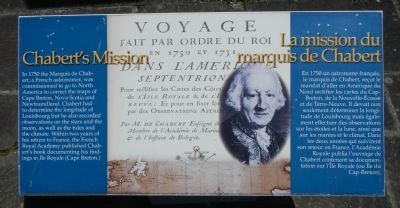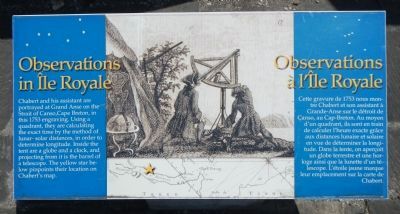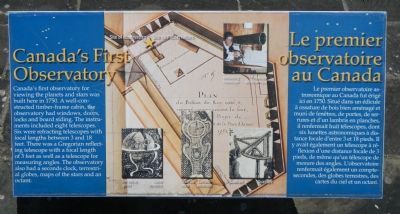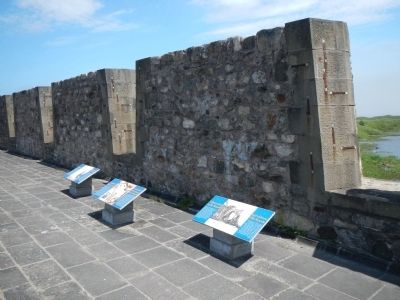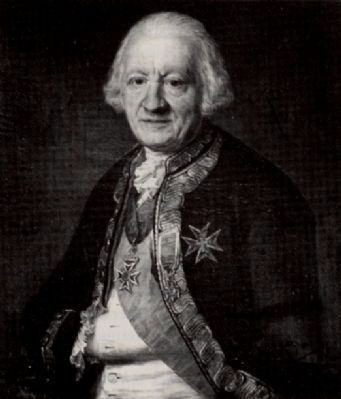Louisbourg in Cape Breton Region, Nova Scotia — The Atlantic Provinces (North America)
Canada’s First Observatory
Le premier observatoire au Canada
Inscription.
Three panels are located at this site.
English:
In 1750 the Marquis de Chabert, a French astronomer, was commissioned to go to North America to correct the maps of Cape Breton, Nova Scotia and Newfoundland. Chabert had to determine the longitude of Louisbourg but he also recorded observations on the stars and the moon, as well as the tides and the climate. Within two years of his return to France, the French Royal Academy published Chabert’s book documenting his findings in Ile Royal (Cape Breton).
French:
En 1750 un astronome français, le marquis de Chabert, reçut le mandat d’aller en Amérique du Nord rectifier les carts du Cap-Brenton, de la Nouvelle-Écosse et de Terre-Neuve. Il devait non seulement déterminer la longitude de Louisbourg mais également effectuer des observations sur les étoiles et la lune, ainsi que sur les marées et le climat. Dans les deux années qui suivirent son retour en France, l’Académie Royale publia l’ouvrage de Chabert contenant sa documentation sur l’Île Royale (ou Île du Cap-Breton.
English:
Chabert and his assistant are portrayed at Grand Anse on the Strait of Canso, Cape Breton, in this 1753 engraving. Using a quadrant, they are calculating the exact time by the method of lunar-solar distances, in order to determine longitude. Inside the tent are a globe and a clock, and projecting from it is the barrel of a telescope. The yellow star below pinpoints their location on Chabert’s map.
French:
Cette graveure de 1753 nous montre Chabert et son assistant à Grande-Anse sur le détroit de Canso, au Cap-Breton. Au moyen d’un quadrant, ils son en train de calculer l’heure exacte grâce aux distances lunaire et solaire en vue de déterminer la longitude. Dans la tente, on aperçoit un globe terrestre et une horloge ainsi que la lunette d’un d’un télescope. L’étoile jaune marque leur emplacement sue la carte de Chabert.
English:
Canada’s first observatory for viewing the planets and stars was built here in 1750. A well-constructed timber-frame cabin, the observatory had windows, doors, locks and board siding. The instruments included eight telescopes. Six were refracting telescopes with focal lengths between 3 and 18 feet. There was a Gregorian reflecting telescope with a focal length of 3 feet as well as a telescope for measuring angles. The observatory also had a seconds clock, terrestrial globes,
map of the stars and an octant.
French:
Le premier observatoire astronomique au Canada fut érigé ici en 1750. Situé dans un édicule à ossature de bois bien aménage et muni de fenêtres, de portes, de serrures et d’un lambris en planches, il renfermait huit télescopes, dont six lunettes astronomique à distance focale d’entre 3 et 18 pieds. Il y avait également un télescope à réflexion d’une distance focale de 3 pieds, de même qu’un télescope de mesure des angles. L’observatoire refermait également un compte-secondes, des globes terrestres, de cartes de ciel et un octant.
Erected by Parks Canada.
Topics. This historical marker is listed in this topic list: Science & Medicine. A significant historical year for this entry is 1750.
Location. 45° 53.442′ N, 59° 59.122′ W. Marker is in Louisbourg, Nova Scotia, in Cape Breton Region. Marker can be reached from Kennington Cove Road. Touch for map. Marker is in this post office area: Louisbourg NS B1C 2L2, Canada. Touch for directions.
Other nearby markers. At least 8 other markers are within 3 kilometers of this marker, measured as the crow flies. Slavery / Freedom (about 150 meters away, measured in a direct line); Marie Marguerite Rose (about 150 meters away); Fizel House (about 210 meters away); Fortress of Louisbourg (approx. 2.1 kilometers away); The Lobster Fishery (approx.
2.5 kilometers away); 19th-Century Lighthouse (approx. 2.7 kilometers away); First Lighthouse Tower (approx. 2.7 kilometers away); First Lighthouse (approx. 2.7 kilometers away). Touch for a list and map of all markers in Louisbourg.
More about this marker. This marker is located on the ramparts of the King's Bastion at Fortress Louisbourg National Historic Site.
Also see . . . Joseph-Bernard, Marquis de Chabert - Dictionary of Canadian Biography. During the winter he had a but constructed on the ramparts at Louisbourg and despite the rigours of the climate successfully established the longitude of the town before spring. (Submitted on December 28, 2014, by Barry Swackhamer of Brentwood, California.)
Additional keywords. Astronomy
Credits. This page was last revised on November 26, 2019. It was originally submitted on December 28, 2014, by Barry Swackhamer of Brentwood, California. This page has been viewed 471 times since then and 40 times this year. Last updated on November 26, 2019, by Steve Stoessel of Niskayuna, New York. Photos: 1, 2, 3, 4, 5. submitted on December 28, 2014, by Barry Swackhamer of Brentwood, California.
